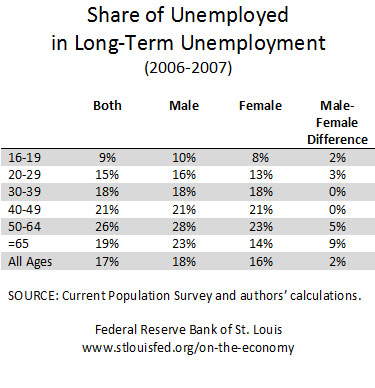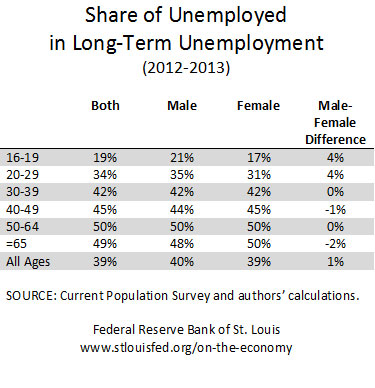Long-Term Unemployment Affected Older Women Most Following Recession

The surge in unemployment during the Great Recession put a spotlight specifically on long-term unemployment (LTU). A recent Economic Synopses essay examined the distribution of LTU before and after the recession.
Research Officer and Economist Alexander Monge-Naranjo and Technical Research Associate Faisal Sohail broke down the shares of the unemployed who were long-term unemployed by age and gender.1 The tables below show these shares for the periods 2006-07 and 2012-13, before and after the Great Recession.


LTU Increasing with Age
Across both periods, the share of unemployed in LTU rose with age, except when reaching 65 and older. The decline when reaching this age was much more pronounced in the earlier period (7 percentage points) than in the later period (1 percentage point).
Males vs. Females
In the first period, the share of males in LTU was higher than or the same as females across all age groups. The largest gap was among the oldest workers, at 9 percentage points. In the second period, however, this is true only for the younger groups. In most older groups, larger shares of women were long-term unemployed.
Increase in LTU after the Great Recession
As the authors noted: “A third, salient finding shown in the table is how dramatically the ratios increased from 2006-07 to 2012-13.” Nearly every male group and all female groups saw the share of unemployed in LTU double from the first period to the second. The largest increase occurred for the oldest group of workers.
Older Women Affected the Most
The authors noted that, among the individual age groups, older women experienced the most dramatic increase in their LTU-to-unemployment ratio. In the earlier period, the ratio was 14 percent, but it moved to 50 percent following the recession. This share overtook the share of men 65 and older in LTU, which was 48 percent. The authors wrote: “The worsening of labor market conditions in the latter period seems to have hit older female workers much harder.”2
Conclusion
The authors concluded: “In sum, men and women of all ages experienced a rise in LTU after the Great Recession. In this essay, we document the lesser-known fact that LTU affected older women more strongly. This group experienced a remarkable change: from a low prerecession LTU-to-unemployment ratio of 14 percent to a postrecession rate of 50 percent.”
Notes and References
1 LTU is defined as workers in continuous unemployment for 27 weeks (six months) or longer.
2 The authors noted that the large increase in LTU might be subject to significant sampling errors, as the number of Current Population Survey respondents in LTU quickly falls once the sample is broken down across genders and age groups.
Additional Resources
- Economic Synopses: Age and Gender Differences in Long-Term Unemployment: Before and After the Great Recession
- On the Economy: How Tight Is the Labor Market?
- On the Economy: Why Are More Young Adults Still Living at Home?
Citation
ldquoLong-Term Unemployment Affected Older Women Most Following Recession,rdquo St. Louis Fed On the Economy, Nov. 17, 2015.
This blog offers commentary, analysis and data from our economists and experts. Views expressed are not necessarily those of the St. Louis Fed or Federal Reserve System.
Email Us
All other blog-related questions

